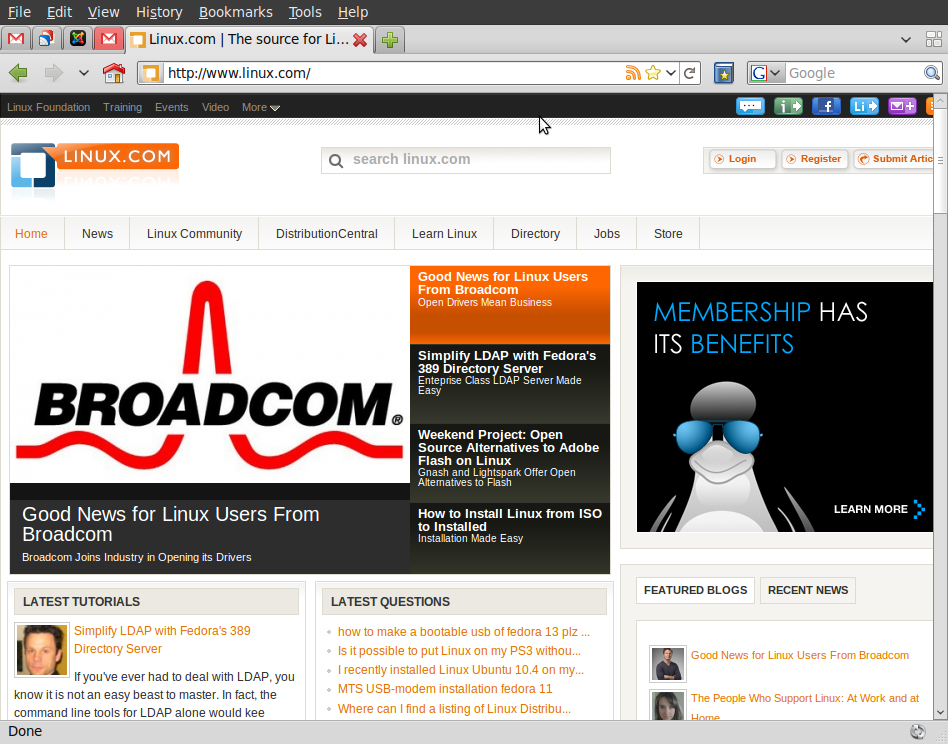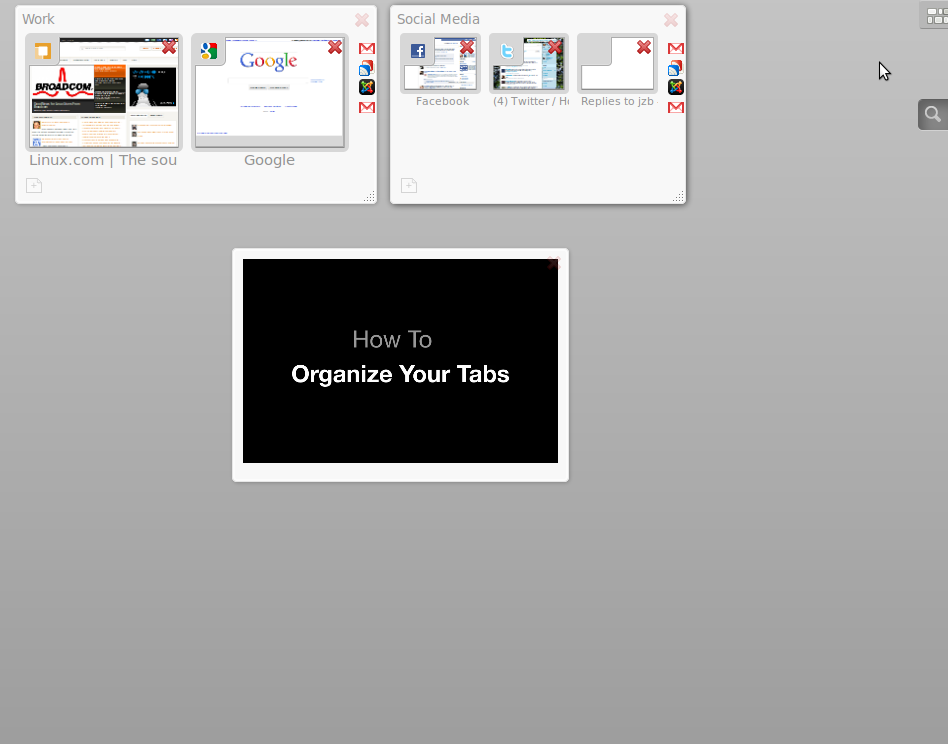Firefox 4.0 is still a bit away from final release, but the time to think about switching is now. The Mozilla Project is releasing Firefox 4.0 beta 6 this week, and the current builds are really good. Why switch? I’ll give you five excellent reasons to jump on the 4.0 train today.
One of the great things about open source development is that you don’t have to wait for the final product to ship to get your hands on it. Case in point, I’ve been running development builds of the Firefox 4.0 series off and on for weeks. You can too, if you don’t mind some rapid changes and possible instability.
Firefox 4.0 is on its 5th beta at the moment, with the 6th beta planned for the end of September and the final release tentatively scheduled for November.
Learning to Fly
Getting Firefox 4 betas onto your system is pretty easy. The Mozilla Project makes tarballs available with Firefox builds for Linux on the beta page. Just download, uncompress (tar -jxvf firefox-4.0b5.tar.bz2), and cd to the firefox directory and run ./firefox. The only problem is that Mozilla only makes 32-bit versions via the beta page. You might be able to find 64-bit Linux versions on the nightly page, though.
You might also want to have Firefox as a native package for your distribution rather than just the tarball. For the major distros, this shouldn’t be hard at all.
Tom ‘Spot’ Callaway has a repo for Fedora 13 and 14. Instructions are available elsewhere, but I haven’t tested the F13 and F14 installs yet.
Ubuntu and Linux Mint users can add the ubuntu-mozilla-daily repository for Lucid like so:
sudo add-apt-repository ppa:ubuntu-mozilla-daily/ppa ; sudo apt-get update ; sudo apt-get install firefox-4.0 firefox-4.0-gnome-support
Note that the last package (firefox-4.0-gnome-support) is optional, but a good idea if you’re running GNOME.
The openSUSE Project has the mozilla:beta repos for users who want to track the Firefox betas for openSUSE.
Whatever you do, be sure to make a backup of your Firefox profile before running Firefox 4.0 betas. I’ve switched back and forth without any problems, but there’s always a chance that it could eat your profile for lunch. Better to be safe than sorry, and all that. To back up your profile, just run tar -cf mozilla-profile-backup.tar ~/.mozilla and keep the resulting file (mozilla-profile-backup.tar) around for safe-keeping.
The Fantastic Five
Now that that’s out of the way, here’s what you’ll be wanting to upgrade to Firefox 4.0 for.
Tab Improvements: A lot of extensions have been written for Firefox over the years trying to enhance tab behavior. Firefox 4.0 brings a number of improvements to tabbing that are well worth the upgrade just on their own.
First and foremost is the Panorama feature (formerly Tab Candy). With Panorama, you can quickly view all your open tabs as tiles, much like the Compiz feature or Mac OS X’s Exposé feature. Even better, you can create groups of pages and switch between them. So I can have one group of tabs that have all my (distracting) social media pages like Facebook, Twitter, and Identi.ca, and then another group with my Web applications, and yet another with all the pages related to stories that I’m writing. Try Panorama for a few days, and you won’t want to go back to Firefox 3.x or Chrome.
 Speaking of Web apps, Firefox takes a cue from Chrome in this release and adds “pinning” for Web apps. The “pinned” tabs take up less space — just the favicon worth of space, and sit on the left-hand side of the browser. Handy for sites like Gmail or a Web-based helpdesk that you need to keep open all the time.
Speaking of Web apps, Firefox takes a cue from Chrome in this release and adds “pinning” for Web apps. The “pinned” tabs take up less space — just the favicon worth of space, and sit on the left-hand side of the browser. Handy for sites like Gmail or a Web-based helpdesk that you need to keep open all the time.
The pinned apps are available in all tab groups, so if you set up pinned tabs for your most-used pages or Web applications, they’ll automatically live in all tab groups. The pinned tabs also survive restarts, so if you exit Firefox (or it crashes…) then you’ll have your pinned apps by default when you restart Firefox.
Finally, Firefox is joining the “tabs on top” movement, though it’s not enabled by default in Firefox 4.0 beta 5 on Linux. You can enable this by going to the Tab bar, right-clicking and selecting Tabs on Top.
Performance Improvements: Firefox has been raked over the coals about performance since Google has been tearing it up with Chrome. It’s no surprise then that a major focus of Firefox 4.0 is improving performance.
For example, Firefox 4.0 includes a new JavaScript engine called JaegerMonkey, which is supposed to be much faster than the engine shipped with Firefox 3.6.x. The improvements are already obvious in the Linux builds, though they’re not optimized yet — so expect to see continual improvements as Firefox marches towards the final 4.0.
The only gripe I have with the tab improvements is the video that just won’t go away. Firefox 4.0 preview builds come with a video in a tab group that shows how to use the Panorama features. That’s great, except when you close its tab group, it just comes back when you restart Firefox.
WebM Video: You probably won’t find a ton of use for this one outside of YouTube right away, but Firefox 4.0 will bring support for WebM. Linux users, in particular, should be very happy to see WebM taking off. An open format for video backed by a major player means that Linux users will be first-class citizens for multimedia in the near future.
How does WebM content look? If you watch some of the videos demoing new FF4 features, you’ll have the chance to choose WebM as one of the supported formats. I’m not a video expert, but they look great to me.
Sync Built In: If you use more than one computer, or just want to be cautious about backing up bookmarks and such, Firefox 4.0 delivers built-in Sync. Using Firefox Sync in Firefox 4.0, you can synchronize passwords, bookmarks, and even open tabs across computers.
Syncing bookmarks isn’t new, I’ve been using Xmarks to do this for quite some time, but Firefox 4.0 gives two advantages. First, it’s baked into the browser — no extension required. Second, Firefox Sync allows you to set up your own server if you don’t want to trust the Mozilla Project to host your data. As organizations go, I’m OK with Mozilla hosting my data — especially since the data is encrypted so that the Mozilla folks couldn’t read it if they wanted to. But for anyone who is feeling particularly paranoid, or just wants to host their data because they can, the option is available.
Test Pilot: One of the things that developers need to make smart decisions is accurate information about the user base and how the software is used. The Moz folks have been working on a feature called Test Pilot for some time, which was available for earlier releases as an extension. Firefox 4.0 will have this baked right in.
Being Mozilla, you have to opt in to sharing any information and the privacy policy is very user-friendly. By making it a default part of Firefox, though, the Mozilla folks should be able to gather quite a bit of useful info to help improve Firefox down the road. I’ve been participating in the Test Pilot surveys for a few months with Firefox 3.x and haven’t noticed any performance hit, and the results that come out of the surveys are really eye-opening. For instance, check out the analysis for the “week in the life of a browser” study.
The features I’ve outlined aren’t the whole of it, of course. Firefox 4.0 has a number of enhancements that are on the way, including a single-button menu (similar to what Chrome has) that will save space and presumably be a bit more intuitive than the current menu system. It hasn’t landed in Linux yet, though.
Firefox 4.0 also includes support for CSS3, JavaScript, and other under-the-hood improvements that you might not be able to spot right away — but should make the Web much more fun and usable down the road.
I have one minor grumble about Firefox 4.0 development, though. The Linux builds have lagged behind Windows and Mac in features. Specifically the Firefox Button (a single-button menu) isn’t enabled for Linux yet. And hardware acceleration of graphics for 2D stuff is going into Windows only, based on DirectX 10 with supported hardware. I’m sure that bringing the same feature to Linux is going to be a bit more challenging, but it’s still disappointing to the Windows version passing ahead of Linux.
The Waiting is the Hardest Part…
The final release of Firefox 4.0 isn’t scheduled until November, and word is that if that date slips then it won’t be released until 2011 (to avoid holidays). Since the November cutoff misses the release dates for Ubuntu 10.10 and Fedora 14, it won’t show up in those distros until Spring 2011. The next openSUSE release is scheduled for March, so Firefox 4.0 should fit right into that schedule.
As mentioned above, though, you don’t need to wait. You can start running Firefox 4.0 right away or as soon as it’s released if you’re willing to run through one or two extra steps.
The betas are not feature complete on Linux, and have some polishing left to do. The single button menu hasn’t been implemented on Linux yet, and the current builds are still a bit sluggish from time to time on Linux. Otherwise, though, the betas seem to be good enough for everyday use and bring enough interesting new features that it’s probably worth the bumpy ride to start running Firefox before it hits the major distro stable releases.





